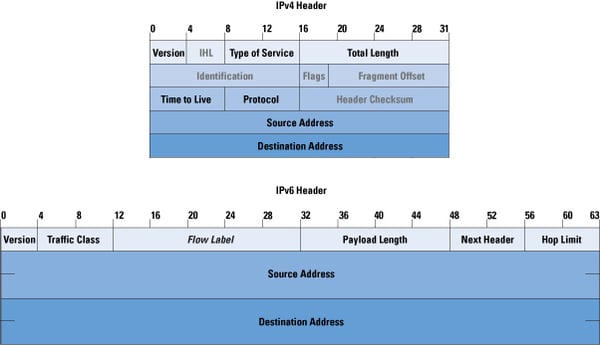
Internet Protocol Version 6 is the next-generation protocol on which the future of the internet, and a huge part of telecommunications in general, is based. In this article, we review the characteristics of IPv6 and examine its benefits and challenges when applied to voice over IP, as well as suggest some practical tips for your deployments.
IPv4 versus IPv6
The term IPv4 is used to refer to the traditional IP protocol that the internet and all of networking has been based on for decades. IPv6 is the next iteration of this protocol, preserving the advantages of its predecessor while rectifying many of its shortcomings. If you’re wondering what happened to IPv5, it never became an official protocol largely because it used IPv4’s 32-bit addressing, as explained below.
An IPv4 address is composed of a 32-bit string of binary digits. This is expressed in the dot-decimal format that we’re all familiar with, such as 10.20.20.14. IPv6 addresses, on the other hand, are composed of a 128-bit string of binary digits, represented in 8 groups of 16 bits, each of which are expressed as four hexadecimal digits. An example of an IPv6 address is the following: 2001:0db8:0000:0000:0000:ff00:0042:8329.
There are ways to shorten this representation to make it easier to input and configure on networking equipment. For example, the above address can be represented as 2001:db8::ff00:42:8329. If you are interested, you can further research the rules governing IPv6 address representation.
For those used to IPv4, IPv6 may initially seem awkward. Nonetheless, it is so well designed that, after gaining some familiarity with it, it quickly becomes intuitive, and for some, even simpler than IPv4.
The advantage of 128-bit IP addresses
IPv4 address exhaustion has been a problem for years (i.e., there aren’t enough IP addresses for all of the nodes connected to the internet). This is one of the most cited reasons for the introduction of IPv6 with its 128-bit addressing. With an address space large enough to assign a unique IPv6 address to every square inch of the earth’s surface (including the oceans) billions of times over, IPv6 is definitely up to the task.
This fact, however, has overshadowed the vast benefits that the new protocol offers over the old. It has been completely reengineered from the bottom up, providing a new, more intuitive architecture, outperforming IPv4 in every aspect of its operation.
Whereas IPv4 requires companion protocols and specialized mechanisms to enable things like security, address conservation, encryption, routing, and even initial configuration parameters, IPv6 has been designed with all of these functionalities built in.
The extensible IPv6 packet header
These built-in capabilities of IPv6 are made possible in part by what are called extension headers. As is the case with IPv4, each IPv6 packet has a header that contains information about where the packet should go and how it should be treated. This header can be viewed as the envelope of a letter being sent through the postal service, upon which the destination and return addresses are indicated, as well as additional instructions concerning how it should get to its destination (for example, air mail or ground transport).
In IPv6, this header is extensible. This means that whenever needed, the header itself can be extended to incorporate supplementary fields with information that enables additional built-in features of the protocol. Features such as security, advanced QoS, encryption, authentication, enhanced routing options, and even capabilities improving device mobility are just some of the mechanisms made possible by the extensible header.
Improved operation
Among the improvements offered by IPv6 are its network support operations. These are processes used to support the function of the network itself, allowing it to operate correctly, as opposed to those used to transmit data.
For example, IPv6 has done away with broadcast communication, which is employed by protocols such as DHCP and ARP in an IPv4 environment. The problem with broadcast communication is that broadcast packets are sent to all hosts on a network regardless of their intended destination, which means the hosts must process each packet and identify then ignore those that don’t belong to them. This, of course, wastes both network bandwidth and host resources. IPv6 has replaced this with a more efficient multicast communication, supplying the necessary network functionality while eliminating the need for hosts to unnecessarily process broadcast traffic.
IPv6 has also employed mechanisms to simplify host configuration such as Stateless Address Autoconfiguration (SLAAC), which uses the Neighbor Discovery (ND) protocol. This mechanism enables an automatic process of negotiation between IPv6 hosts and gateways, resulting in basic network connectivity without the intervention of an administrator.
Benefits of IPv6 beyond a larger address space
Compared with IPv4, IPv6 is able to deliver more comprehensive communication services to network applications. These include:
Inherent security – IPv6 has two predefined extension headers reserved for security. One deals with authentication and the other deals with payload confidentiality using encryption. Whereas IPv4 requires the additional implementation of the IP Security (IPsec) framework to achieve this, IPv6 has this capability built into the protocol itself.
Automatic configuration of IPv6 network parameters – To allow hosts to obtain the IP parameters to communicate, IPv4 requires either the manual configuration of IP network parameters on a host, or the manual configuration of a DHCP server on the network. With IPv6, fundamental communication is automatically achieved via SLAAC without the need for any configurations whatsoever. This is exceptionally useful for connecting devices such as smart TVs, media centers, smart appliances, and wireless devices within an environment where there may be no dedicated network professional to prepare and configure the network, thus truly providing plug-and-play network connectivity.
No more complicated subnetting calculations – In order to conserve IPv4 addresses, complex subnetting calculations must be made to assign address spaces that are appropriate in size for the number of hosts. For example, if the marketing department has 11 employee workstations, it would be prudent to assign an address space of 16 IPv4 addresses (and not 256, for example), to conserve IPv4 addresses. Because the IPv6 address space is so vast, there is no need for any such subnetting, as all IPv6 subnets, whether they have two or two hundred hosts in them, can be of the same size, eliminating the need for complex and time-consuming calculations in the network design process.
Elimination of NAT – Network Address Translation (NAT) is a technique that has been used for years to conserve IPv4 addresses, and is primarily employed on the edge devices of enterprise networks. IPv6’s enormous address space eliminates the need for NAT, since it allows each internal device on all networks to have a unique public and globally routable IPv6 address.
Benefits of IPv6 for VoIP
VoIP networks benefit from IPv6 in a number of ways.
No more NAT – NAT can potentially become a nightmare for IP telephony professionals, since it is often the culprit in situations where calls between IP phones are connected, but voice is only heard in one direction. This is a phenomenon known as one-way voice. This occurs because NAT disrupts the end-to-end nature of communication over an IP network. IPv6 eliminates the need for NAT, and thus eliminates all problems associated with VoIP traffic traversing a NAT mechanism.
End-to-end Security – With IPv6, it is simple to enable security for both voice and control packets traversing an IP telephony network. IPv6-enabled IP phones, voice gateways, and IP PBXs are capable of activating these security options with a simple configuration parameter. By enabling security on the end devices that generate and receive the traffic, there is no need to further configure security parameters on intermediary network devices.
Inherent QoS – IPv6 introduces a couple of fields in its header that are reserved specifically for the operation of Quality of Service mechanisms. IPv6 can identify specific flows of packets so that IPv6 routers can verify that packets belonging to the same voice conversation, or flow, are sent over the same network route, hence maintaining both an orderly and timely delivery of the packets to their destination.
Challenges of IPv6 for VoIP
Almost all news about IPv6 is good news. However, for VoIP, there is one drawback that you should be aware of. An IPv4 packet has a header size of 20 bytes, whereas an IPv6 packet header, without any extension headers, has a size of 40 bytes. This is due to the increase in size of the IPv6 addresses themselves. This comparison is further illustrated in the following diagram.

An increase of 20 bytes per packet for data packets that are typically 1500 bytes in size may not seem substantial; that’s an increase of just over 1%. However, because the payload of VoIP packets is quite small in size – on the order of 20 to 160 bytes depending on the codec being used – an increase of just 20 bytes can have a substantial impact. Take the G.729 codec that has a voice payload of 20 bytes. With IPv4, this would result in a 40-byte packet including the header. With IPv6, this results in a 60-byte packet with the header. This is a 50% increase in size per packet, resulting in a 50% increase in required bandwidth. The smaller the payload of the packet, the more pronounced the increase in required bandwidth will become. If IPv6 header extensions are used, the required bandwidth will increase even further.
This is not a make-or-break issue for IPv6 and VoIP by any means. Yet, professionals should be aware of this phenomenon to appropriately size network links carrying VoIP.
What to keep in mind for your VoIP deployment
If you haven’t yet migrated to IPv6, you will in the future. For this reason, it is important to be ready for the upcoming changes. Here are some pointers to keep in mind for VoIP:
- Don’t be afraid of embracing IPv6; chances are, you’ll eventually prefer it over IPv4
- Make sure your VoIP equipment supports it; most vendors’ new equipment does
- Take advantage of enhanced IPv6 QoS capabilities
- Rid yourself of pesky NAT issues with VoIP
- If your network is due for an upgrade soon, incorporate a migration to IPv6
Conclusion
While IPv4 will still be around for a long time, IPv6 is the future and is quickly gaining ground on both the internet at large and on internal networks of enterprises big and small. The benefits it offers for VoIP telephony far outweigh any drawbacks, so the sooner you are able to migrate your customers, the better.
You may also like:
VoIP protocols: H.323 and MGCP as alternatives to SIP
Know your protocols: VoIP protocols that work together with SIP
Quality of service must-haves for converged networks









Comments